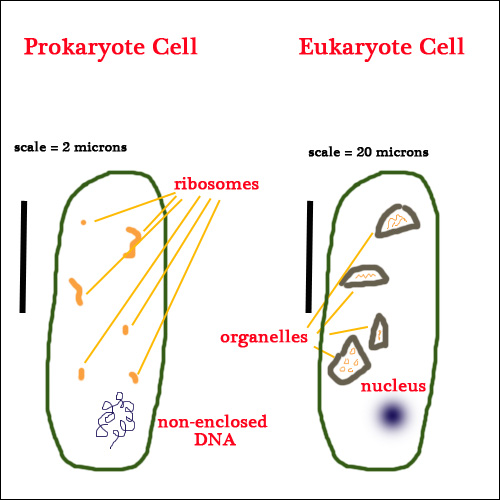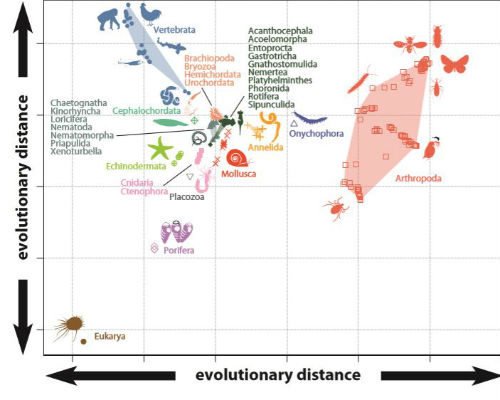Illuminating the Evolution of Animal Life – Humbling Thoughts
Recently two scientific papers have been published that delve deep into the origins of life on Earth. In one paper, published in the “Proceedings of the National Academy of Sciences USA”, the origins of animal body plans (Animalia) were explored, analysing the anatomical designs of animals, looking at how animal life half a billion years ago evolved and changed over time to bring us the biodiversity we see today and that which is preserved in the fossil record.
Tracing the Origins of the Animalia
This study mapped shared characteristics and one of the conclusions drawn from the research was that all those weird and wonderful Cambrian creatures, as preserved in the Burgess Shales of British Columbia or in the Sirius Passet Lagerstätte of Greenland, are actually less weird than the butterflies and birds that you might see in your own garden.
The Body Plans of Bizarre Cambrian Creatures Such as Hallucigenia are not that Bizarre According to a New Study

Picture credit: Royal Ontario Museum/Dr Jean Bernard Caron with additional annotation by Everything Dinosaur
In the second scientific paper, which shares a number of authors with the first publication and was published last month in the journal “Nature: Ecology & Evolution”, researchers examined the evolution of all life as a whole, conducting research using a new molecular clock analysis to plot a unified timescale for the early evolution of life on our planet.
What is the Molecular Clock?
The idea of a molecular clock is based on the idea that evolutionary changes occur at regular time intervals, that the rate of genetic change (mutation), has remained constant over time. The molecular clock uses this premise, it plots the number of differences in the genomes of two living species (for example a human and a bacterium) and these changes are proportional to the time since they shared a common ancestor.
Using this methodology, the scientists, from the universities of Bath and Bristol were able to avoid putting too much reliance on a very fragmentary and often highly controversial early life fossil record.
This research team concluded that the last universal common ancestor of cellular life existed more than 3.9 billion years ago and that the crown clades of two primary divisions of life – Eubacteria and Archaebacteria emerged less than 3.4 billion years ago. Furthermore, the scientists concluded that modern eukaryotes (organisms whose cells have a nucleus enclosed within membranes – animals, protists, plants and fungi), don’t constitute a primary lineage of life and emerged relatively late during life on Earth’s evolutionary history (around <1.84 billion years ago).
Eukaryote Cell Compared to the Prokaryote Cell Typical of Eubacteria and Archaebacteria

Picture credit: Everything Dinosaur
Did Animal Body Plans Emerge Over Deep Time or Come About in Response to Sudden Changes?
This was the question that the researchers set out to answer in the paper published the “Proceedings of the National Academy of Sciences USA”. It is agreed that complex animal life evolved from single celled eukaryotes and that multi-cellular animals diversified into thirty or forty distinct anatomical body plans, but when and how did these body plans emerge? Were the majority of these different body plans already in existence after the Cambrian explosion, some 500 million years ago?
To answer these questions the research team, consisting of scientists from Bristol University, Dartmouth College in New Hampshire and the University of West Georgia, looked at features from living groups of animals and cross-referenced those characteristics against what can be identified from the fossil record.
Professor Philip Donoghue (Bristol University) a co-author of both scientific papers explained:
“This allowed us to create a ‘shape space’ for animal body plans, quantifying their similarities and differences. Our results show that fundamental evolutionary change was not limited to an early burst of evolutionary experimentation. Animal designs have continued to evolve to the present day, not gradually as Darwin predicted, but in fits and starts, episodically through their evolutionary history.”
Mapping the Evolution of Different Types of Animal Body Plan
Picture credit: Bristol University
The research team propose that major expansions in the type of animal following the Cambrian explosion aligns with other major ecological transitions such as the conquest of terrestrial environments.
Bradley Deline (University of West Georgia) added:
“Our results are important in that they highlight the patterns and pathways in which animal body plans evolved. Many of the animals we are familiar with today are objectively bizarre compared with the Cambrian weird wonders. Frankly, butterflies and birds are stranger than anything swimming in the ancient sea.”
Trying to Fit Extinct Animals into the Study
Contributors to both scientific papers, James Clark (Bristol University) and Mark Puttick (Milner Centre for Evolution, University of Bath), looked at how fossils could be incorporated into this research.
Dr Puttick stated:
“One of the problems we had is that our study is mostly based on living species and we needed to include fossils. We solved the problem through a combination of analysing the fossils and using computer models of evolution.”
James Clark added:
“The fossils plot intermediate of their living relatives in shape space. This means that the distinctiveness of living groups is a consequence of the extinction of their evolutionary intermediates. Therefore, animals appear different because of their history rather than unpreserved jumps in anatomy.”
Studying the Genomes of Different Animals (Animalia)
Jenny Greenwood, also from the University of Bristol’s School of Earth Sciences, wanted to explore how this study might be reflected in the genomes of different organisms. She wanted to work out which of the many proposed genetic mechanisms drove the evolution of animal body plans.
Jenny commented:
“We did this by collecting data on the different genomes, proteins, and regulatory genes, that living animal groups possess. The differences in anatomical designs correlate with regulatory gene sets, but not the type or diversity of proteins. This indicates that it is the evolution of genetic regulation of embryology that precipitated the evolution of animal biodiversity.”
These researchers have concluded that animal evolution has been permitted or driven by gene regulatory evolution.
Two Papers Helping to Improve our Understanding of the Evolution of Life on Earth

Picture credit: Everything Dinosaur
Everything Dinosaur acknowledges the help of a press release from Bristol University in the compilation of this article.
The two scientific papers:
“Integrated Genomic and Fossil Evidence Illuminates Life’s Early Evolution and Eukaryote Origin” by Holly C. Betts, Mark N. Puttick, James W. Clark, Tom A. Williams, Philip C.J. Donoghue and Davide Pisani published in the journal Nature: Ecology & Evolution.
“Evolution of Metazoan Morphological Disparity” by B. Deline, J. Greenwood, J. Clark, M. Puttick, K. Peterson and P. Donoghue published in the Proceedings of the National Academy of Sciences USA.
Visit the Everything Dinosaur website: Everything Dinosaur.








Leave A Comment